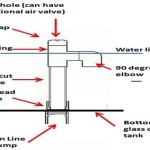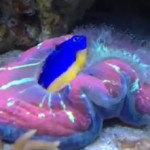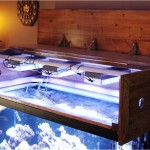Monthly Archives: April 2012
Lightning Maroon Clownfish
The lightning Maroon Clownfish is a one of a kind truly stunning clown fish that was caught of Papua New Guinea. One of a kind fish like this usually go to people willing to pay biiiig money for them but in this case Blue Zoo Aquatics opted to make sure that it went to an established breeder instead to make sure that we all might get to enjoy these stunning color morph in the future. It would not be the first time a new color morph has been developed form a single original fish.
Although the lightning Maroon Clownfish paired of last year (2011) the pair has so far not laid any eggs or produced any offspring.
Pairing video:
The breeder has now decided to try to use a technique called “Double down” in which you move a batch of eggs another couple laid to the couple you want to start breeding. The idea is that either the fish start caring for the eggs that are given to them, which usually triggers them to start laying their own egg before long, or they eat the eggs that are given to them and get a very nutritious meal. In this case, the eggs, taken from an Onyx Percula spawning, were received somewhat well and the pair is showing signs of caring for the eggs which might be a good sign and hopefully we will get to see baby lightning Maroon Clownfish before long. If you want more info or keep up to date with the attempts to spawn the lightning Maroon Clown fish you can visit the lightning project website and if you want more info on this particular breeding attempt you can click here.
The lightning Maroon Clownfish guarding the new eggs:
Coral Diseases
Background
This is a very difficult topic to learn about, as for the most part, not enough scientific study has been completed yet. Coral disease research really did not get a lot of focus until the mid 1970s with many of the common diseases only becoming properly identified in the early 1990s. With the increasing levels of pollutants in the waters of the coral reefs, combined with the effects of global warming, more and more diseases have be developing, along with the frequency they are being found in among the ocean’s coral reefs.
This is (IMO) a very serious threat to the long-term health of our coral reefs today. For example, White band disease has had a devastating impact in the coral reefs in the Florida Keys (killing ~95% of all Acropora SPS corals), and in the Caribbean (infecting ~50% of the shallow water, mostly Elkhorn SPS corals within the first five years after this disease was discovered there). During the past 10 years, the Caribbean coral reefs are being affected more and more each year. New diseases have even started to surface that affect coralline algae (Coralline Lethal Algae Disease) which could also have a significant impact on health of our coral reefs.

Mixing Saltwater
Mixing saltwater
Perhaps the most vital part of the marine aquarium is properly mixing salt water.
The reefs of the world are the most stable environments on Earth, despite human activity and pollution tipping that balance in the reefs of the Caribbean Sea and the east coast of Florida. The natural reef water possesses a set ratio of salts, minerals and trace elements. Temperatures vary little, and in most reefs, not at all.
Several different manufacturers product synthetic salts that posses the proper ratio of minerals and trace elements, but there are some brands that are superior to others in that respect. Seek out impartial reviews to give you an idea which salt mix to buy.
Natural Sea Water (NSW) contains 11 major elements and a handful of trace elements. To simulate that in our marine tanks one must make every effort to be as close to the natural world as possible.

Aquarium Plumbing Basics
When you set out to plumb an aquarium set-up with a sump, the more planning / thought you put into the original set-up, the better it will be in the long run. This is not a very hard thing to do at all, if you focus on the basics and understand them. I tend to think of it in flowing different steps: A) Planning of your flow rates, B) planning the material types and sizes, and C) installation / set-up of the plumbing system. All of what you are about to read below is based on my experiences with various data from some North American manufactures of plumbing products (IPEX, Canplas, and Boshart) which is also detailed in the American Society for Testing and Materials (ASTM) standards.
I will explain what I mean by each step then I will show you examples from one of my reef tanks

Open brain corals capable of catching and consuming live healthy fish
You seldom think about corals catching and eating your otherwise healthy fish but it might be good to know that it does happen. You might want to avoid coral species such as Trachyphyllia and other large polyp stone corals in tanks where you keep fish you really care about. The risk of something like this happening is small but ever present.
The video below shows an open brain coral in the tank of Dmitry Tumanovthat has caught and is consuming an otherwise healthy, living, large azure damsel fish. Dimitry shot this video after having lost several fish that was no where to be found.
Via reefbuilders

Calcium Reactors
Calcium reactors
Calcium reactors (or as I like to call them mineral reactors) are one of the best ways to maintain natural sea water levels in a marine aquarium. Once adjusted, they are also the easiest way to maintain NSW (Natural Sea Water) levels. Not only do they maintain Calcium and alkalinity levels, but also Magnesium and several trace elements This article will describe each component of a Calcium reactor as well as setting up and adjusting one. With a properly adjusted Calcium reactor and good media, daily dosing becomes a thing of the past, which give you more time to enjoy your reef.
Giant Marine Clams
Giant Clams
For many, many years out reach for marine aquarium keepers are the giant clams, Tridacna species. And to this day. though captive raised, giant clams are not for nascent keepers.
That said they can be kept if one has the intensity and quality of lighting, a steady temperature, and natural sea water levels of minerals, and sufficient alkalinity to buffer it.
The two most common reasons why giant clams fail in aquariums are insufficient light, and predation. In the former, clams contain a symbiotic algae species in their flesh. Like most all algae (other than cyanobacteria of course), the algae that give the vivid colors of giant clam flesh photosensitize light. The wastes from that photosynthesis are sugars that feed the clam. Also, giant clams need a brisk, chaotic flow, similar to that needed for Acropora species corals.

Reef Lighting
This article was written by myself and Cliff. The first part was written by me (Dave66), and Cliff gives an overview of LED (Light Emitting Diode) lighting.
—-
Perhaps the most important and vital piece of equipment one can buy for their reef aquarium is lighting.
Fully 95 percent of corals available in shops and online are photosynthetic. That is, they have photosynthetic bacteria in their tissues (zooxanthellae). The bacteria ‘feed’ on the light, and the sugars they produce as waste feeds the coral.
On the tropical reef it’s the sun that powers the photosynthesis of zooxanthellae. In the aquarium, it is the responsibility of the keeper to simulate the sun in their aquariums. Lighting is one of the major costs in starting a reef tank. Continue reading
Marine Reactors
Reactors
In marine aquariums, available are several types of reactors. Reactors are simply acrylic cylinders that contain some type of media. Internal construction varies, depending on the brand and type of reactor.
What follows are reactor types and their purpose.
—–
Perhaps the most valuable of the reactors in a reef aquarium is a Calcium Reactor.
Maintaining natural sea water levels of minerals and trace elements, and alkalinity of a sufficient level to buffer them, is a challenge for many new and not so new reef aquarium keepers.
A Calcium Reactor can negate that challenge. The reactor is loaded with an aragonite media or similar, which as it dissolves, continually maintains natural sea water levels of minerals and trace elements, and the optimal level of alkalinity. Having a Calcium Reactor is cost effective in the long run, since it will keep you from having to buy products for the marine minerals and trace elements, plus alkalinity, regularly.